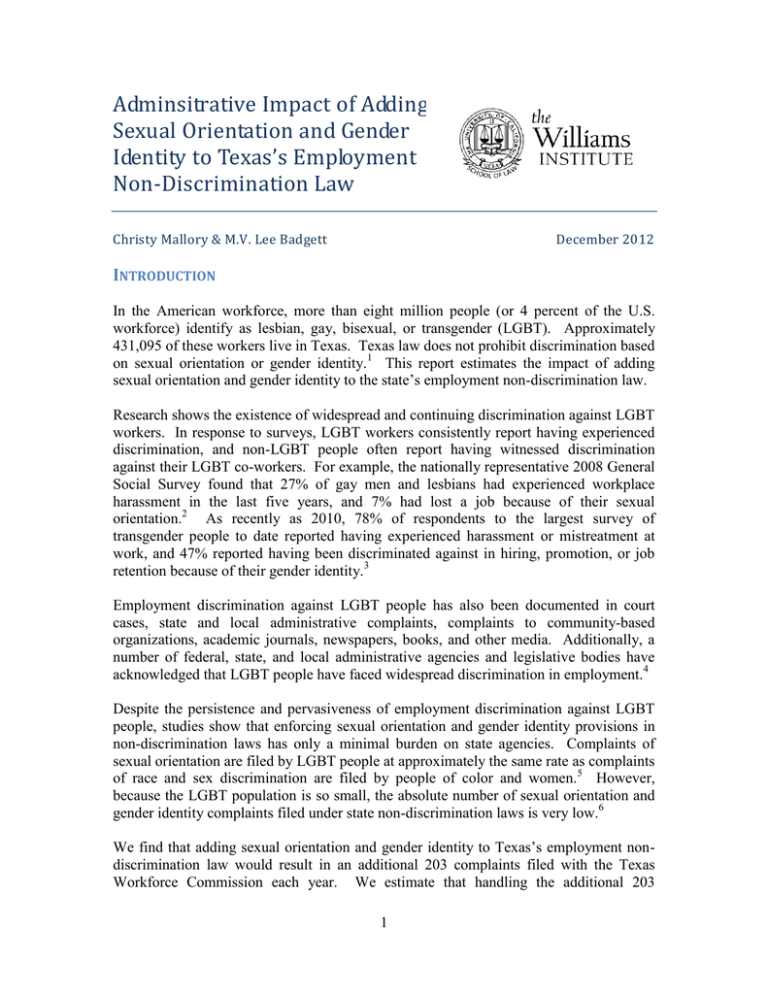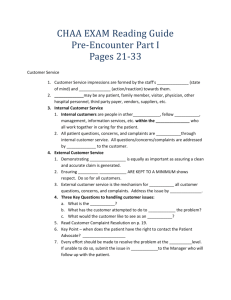
Adminsitrative Impact of Adding
Sexual Orientation and Gender
Identity to Texas’s Employment
Non-Discrimination Law
Christy Mallory & M.V. Lee Badgett
December 2012
INTRODUCTION
In the American workforce, more than eight million people (or 4 percent of the U.S.
workforce) identify as lesbian, gay, bisexual, or transgender (LGBT). Approximately
431,095 of these workers live in Texas. Texas law does not prohibit discrimination based
on sexual orientation or gender identity.1 This report estimates the impact of adding
sexual orientation and gender identity to the state’s employment non-discrimination law.
Research shows the existence of widespread and continuing discrimination against LGBT
workers. In response to surveys, LGBT workers consistently report having experienced
discrimination, and non-LGBT people often report having witnessed discrimination
against their LGBT co-workers. For example, the nationally representative 2008 General
Social Survey found that 27% of gay men and lesbians had experienced workplace
harassment in the last five years, and 7% had lost a job because of their sexual
orientation.2 As recently as 2010, 78% of respondents to the largest survey of
transgender people to date reported having experienced harassment or mistreatment at
work, and 47% reported having been discriminated against in hiring, promotion, or job
retention because of their gender identity.3
Employment discrimination against LGBT people has also been documented in court
cases, state and local administrative complaints, complaints to community-based
organizations, academic journals, newspapers, books, and other media. Additionally, a
number of federal, state, and local administrative agencies and legislative bodies have
acknowledged that LGBT people have faced widespread discrimination in employment.4
Despite the persistence and pervasiveness of employment discrimination against LGBT
people, studies show that enforcing sexual orientation and gender identity provisions in
non-discrimination laws has only a minimal burden on state agencies. Complaints of
sexual orientation are filed by LGBT people at approximately the same rate as complaints
of race and sex discrimination are filed by people of color and women.5 However,
because the LGBT population is so small, the absolute number of sexual orientation and
gender identity complaints filed under state non-discrimination laws is very low.6
We find that adding sexual orientation and gender identity to Texas’s employment nondiscrimination law would result in an additional 203 complaints filed with the Texas
Workforce Commission each year. We estimate that handling the additional 203
1
complaints would cost the state approximately $1.3 million – $1.6 million over five
years.
COMPLAINT ESTIMATE
We estimate that approximately 203 complaints of sexual orientation or gender identity
employment discrimination would be filed with the Texas Workforce Commission
(TWC) each year. To reach this estimate, we draw on Census data from Texas to
estimate the size of the LGBT population in the state, and apply a national sexual
orientation and gender identity complaint rate to that population. We have previously
used this methodology to estimate the number of complaints that would be filed on the
basis of sexual orientation and gender identity in other states, including Utah7 and South
Dakota.8
Census data show that same-sex couples are not evenly distributed throughout the United
States.9 Instead, some states have more same-sex couples per capita than other states.
For our analysis, we assume that LGBT people in the workforce distribute across the U.S.
similarly to same-sex couples. We estimate how many LGBT workers live in Texas by
applying the percentage of U.S. same-sex couples that live in Texas to the number of
LGBT people in the U.S. workforce.
According to 2010 Census data, 46,401 same-sex couples live in Texas.10 This number
represents 7.2% of the 646,464 same-sex couples in the U.S.11 Averaging data from five
population-based surveys, a recent study found that 3.8%12 of adults in the U.S. identify
as LGBT.13 Applying this percentage to the number of people in the U.S. workforce
(157,564,231)14 indicates that there are 5,987,441 LGBT people in the U.S. workforce.
We then multiply the number of LGBT people in the U.S. workforce by 7.2% (the
percent of same-sex couples that live in Texas) to determine the size of the LGBT
workforce in Texas: 431,095.
Next, we apply the rate of complaints filed on the basis of sexual orientation or gender
identity to the number of LGBT workers in Texas to determine how many complaints
will be filed annually if these characteristics are added to the employment nondiscrimination law. We use the national average complaint rate from a 2008 study that
analyzed administrative complaint data from 17 states that prohibited sexual orientation
discrimination at that time.15 The study found that across these states, the average rate of
complaints filed on the basis of sexual orientation was 4.7 per 10,000 LGB workers.
The data gathered for the 2008 study included all employment discrimination complaints
filed on the basis of sexual orientation; it was not limited to complaints filed by LGB
employees. Heterosexual employees may also file complaints under sexual orientation
non-discrimination laws if they were discriminated against because of their
heterosexuality or because they were perceived to be LGB. However, we use the LGB
workforce as the underlying population for purposes of our analysis because LGB
employees likely file the vast majority of sexual orientation discrimination complaints.16
2
There is not sufficient data to make a similar calculation of the average rate of complaints
file on the basis of gender identity. 17 Therefore, we assume that this rate is also 4.7 per
10,000 transgender workers.
Applying the national complaint rate (4.7 per 10,000 LGBT workers) to the number of
LGBT workers in Texas suggests that 203 complaints of sexual orientation and gender
identity discrimination would be filed annually if these characteristics were added to the
state’s employment non-discrimination law.
COMPARISON
BOARD
WITH
ESTIMATE PREPARED
BY THE
TEXAS LEGISLATIVE BUDGET
In March, 2011, the Texas Legislative Budget Board (LBB) estimated the fiscal impact of
adding sexual orientation and gender identity to the state’s employment nondiscrimination law. The LBB estimated that 474 complaints of sexual orientation or
gender identity discrimination would be filed each year under the new law.
LBB’s analysis assumed that complaints would be filed by the entire Texas workforce at
a similar rate as the entire California workforce. To estimate the number of complaints
based on this assumption, the LBB divided the population of Texas by the population of
California, and then multiplied by sexual orientation and gender identity complaints filed
annually in California ((23,904,380/36,553,215) x 724.33 = 473.68).
Our methodology differs from the LBB methodology slightly, which has resulted in a
lower estimate. First, we have taken into account that a smaller percentage of the
workforce in Texas is LGBT than in California. The LBB analysis assumes that the
percentage is the same in both states. In effect, our analysis is based on a smaller
underlying LGBT population than the LBB analysis.
Second, to determine how many complaints LGBT workers in Texas would file annually,
we used the national average rate of complaints filed based on sexual orientation. 18 The
LBB used California’s complaint rate. We have used the average complaint rate rather
than any one state’s complaint rate because it reduces the risk that the rate applied
represents an extreme in either direction.
COST ESTIMATE
Using information provided in the LBB report, we can roughly estimate the cost
associated with handling the additional 203 complaints we expect would be filed if Texas
added sexual orientation and gender identity to its employment non-discrimination law.
We emphasize that this is only a rough estimate, as we have only limited information
about the costs of enforcing complaints of employment discrimination in Texas. It would
be possible to provide a more accurate estimate if we had more detailed information
about these costs.
3
In its analysis, the LBB determined the increase in staff and operating costs that the TWC
would incur in order to enforce the additional 474 complaints. Using expense data from
the TWC, the LBB estimated that TWC would have to hire seven new full-time
employees to handle the additional 474 complaints per year. This would result in a total
increase in TWC salaries of $411,000 and benefits of $114,505. The LBB further
estimated that TWC would spend an additional $82,200 in indirect costs, an additional
$12,110 in other operating costs per year, and an additional $1,800 in travel per year.
Finally, the LBB estimated the TWC would incur $47,117 in nonrecurring costs in the
first year, which accounts for the difference estimates in Year 1 and in Year 2 – Year 5.
It will cost the state less to enforce the law if fewer complaints are filed. From the
information provided in the LBB report, it is not possible to determine exactly how much
less it would cost the state to handle 203 additional complaints as opposed to 474
additional complaints. The nature of some of the expenses described in the LBB report
suggests that there might not be a pro rata reduction in costs for each fewer complaint
filed. For example, the LBB stated that TWC would have to one new supervisor to
manage five new investigators. Even if it is possible to estimate how many fewer
investigators would be needed if only 203 additional complaints were filed each year, it is
not clear how many new investigators trigger the need for a new supervisor.
Nevertheless, 203 complaints is less than half of the complaints estimated by the LBB
(43% of the LBB estimate) and the bulk of the costs of enforcement (investigator salaries
and benefits) would logically increase or decrease with the number of complaints on a
near pro rata basis. Thus, it is reasonable to assume that the costs associated with
enforcing these complaints would be close to 43% of the LBB cost estimate. Here, we
assume a 10% range, figuring that the costs would likely be between 40% and 50% of
what the LBB estimated. This would amount to a cost of approximately $1.3 million –
$1.6 million over five years; approximately $270,000 – $330,000 in the first year and
$250,000 - $310,000 each subsequent year.
Additionally, it will cost the state less to enforce the law if the EEOC shares the costs of
enforcement of some complaints, as described below.
IMPACT OF RECENT LEGAL DEVELOPMENTS UNDER TITLE VII
The Equal Employment Opportunity Commission (EEOC) has held that discrimination
based on gender identity or expression violates Title VII’s requirement that employers
not discriminate based on sex.19 The decision means that all 53 EEOC field offices
throughout the United States will accept and investigate complaints filed by employees
who believe that they were discriminated against based on their gender identity.20
The EEOC’s decision most likely changes how costs associated with gender identity
complaints would be covered in Texas. In light of the decision, the EEOC should be
responsible for sharing the costs of enforcing gender identity complaints with the Texas
General Revenue Fund pursuant to their fixed price cooperative agreement. Essentially
this is because both the Texas state non-discrimination law and Title VII would prohibit
4
discrimination based on gender identity. The EEOC decision does not change how the
agency handles complaints of sexual orientation discrimination, so the Texas General
Revenue fund would still be responsible for the costs associated with these complaints as
explained by LBB.
However, there is a possibility that the fixed price cooperative agreement requires the
TWC to accept any sex discrimination complaints that are enforceable either under Texas
law, or under federal law. If this is the case, the TWC is already required to accept
complaints of gender identity discrimination because the EEOC has decided that this type
of discrimination is prohibited sex discrimination under Title VII. As such, adding
gender identity to the state’s non-discrimination law would not result in higher costs than
the state is already incurring.
In short, we are unable to determine how gender identity complaints are being handled by
the TWC in light of the EEOC’s decision without more information about the fixed price
cooperative agreement. For purposes of our analysis in this memo, we have assumed that
the TWC is not currently required to accept complaints of gender identity discrimination.
This assumption results in a higher cost estimate than we would reach if we were to
assume that the complaints are already being accepted by the TWC.
CONCLUSION
This report estimates the impact of adding sexual orientation and gender identity to
Texas’s employment non-discrimination law. We conclude that if Texas added these
characteristics to its law, an additional 203 complaints would be filed each year. Based
on the information provided in the LBB analysis, we roughly estimate that handling these
additional complaints would cost the state $1.3 million – $1.6 million over five years;
$270,500 – $330,000 in the first year and $250,000 - $310,000 each subsequent year.
5
ENDNOTES
1
TEX. LAB. CODE ANN. § 21.051 (2012).
Brad Sears & Christy Mallory, The Williams Instit., Documented Evidence of Employment
Discrimination & Its Effects on LGBT People 2 (2011), available at
http://williamsinstitute.law.ucla.edu/wp-content/uploads/Sears-Mallory-Discrimination-July-20111.pdf.
3
Jamie M. Grant, Lisa A. Mottet, Justin Tanis, Jack Harrison, Jody L. Herman, & Mara Keisling, Injustice
at Every Turn: A report of the National Transgender Discrimination Survey 51 (2011), available at
http://www.thetaskforce.org/downloads/reports/reports/ntds_full.pdf.
4
Sears & Mallory, supra note 2.
5
M.V. Lee Badgett, Christopher Ramos & Brad Sears, The Williams Instit., Evidence of Employment
Discrimination on the Basis of Sexual Orientation and Gender Identity: Complaints Filed with State
Enforcement Agencies 1999-2007 (2008), available at http://williamsinstitute.law.ucla.edu/wpcontent/uploads/Badgett-Sears-Ramos-Emply-Discrim-1999-2007-Nov-08.pdf; William B. Rubenstein, Do
Gay Rights Laws Matter?: An Empirical Assessment, 75 S. CAL. L. REV. 66, 79-81 (2001).
6
Badgett, Ramos, & Sears, supra note 5.
7
Clifford Rosky, Christy Mallory, Jenni Smith, & M.V. Lee Badgett, The Williams Instit., Employment
Discrimination against LGBT Utahns (2011), available at http://williamsinstitute.law.ucla.edu/wpcontent/uploads/Rosky-Mallory-Smith-Badgett-Utah-Emp-Discrim-Jan-11.pdf.
8
Naomi G. Goldberg, M.V. Lee Badgett, & Christopher Ramos, The Williams Instit., The Impact of
Employment Non-Discrimination Legislation in South Dakota (2010), available at
http://williamsinstitute.law.ucla.edu/wp-content/uploads/Goldberg-Badgett-Ramos-SouthDakota-ENDAJan-2010.pdf.
9
See Williams Institute, United States Census Snapshot: 2010, available at
http://williamsinstitute.law.ucla.edu/wp-content/uploads/Census2010Snapshot-US-v2.pdf (last visited Oct.
24, 2012).
10
Williams Institute, Texas Census Snapshot: 2010, available at http://williamsinstitute.law.ucla.edu/wpcontent/uploads/Census2010Snapshot_Texas_v2.pdf (last visited Oct. 24, 2012).
11
For the number of same-sex couples in the U.S., see Williams Institute, United States Census Snapshot:
2010, supra note 9.
12
Gary J. Gates, The Williams Instit., How Many People are Lesbian, Gay, Bisexual, and Transgender? 1
(2011), available at http://williamsinstitute.law.ucla.edu/wp-content/uploads/Gates-How-Many-PeopleLGBT-Apr-2011.pdf.
13
Similarly, findings from the 2012 Gallup Daily Tracking Survey—the largest single study of the
distribution of LGBT people to date—found that 3.4% of adults in the U.S. identify as LGBT. Sharon
Jayson, New Survey: 3.4% of U.S. Adults are LGBT, USATODAY, Oct. 19, 2012.
We use the figure from the review (3.8%, Gates, supra note 12) rather than the figure from the
Gallup poll because the review takes into account some of the variation across surveys by averaging. In
contrast, the 3.4% figure is based on one survey question on one survey instrument gathered through phone
interviews. Research suggests that respondents may be more willing to identify as LGBT in more
anonymous survey methods (e.g., internet or computer-assisted interviews), which may bias the Gallup
estimate slightly downward.
14
American Community Survey, American FactFinder, 2011 ACS Table S2301: Employment Status, 1year estimates, available at http://factfinder2.census.gov/faces/nav/jsf/pages/index.xhtml#none (search
“topic or table name” for S2301; then select “2011 American Community Survey 1-Year Estimates). The
workforce number is calculated by multiplying the population age 16 and over (246,194,111) by the
percent in the labor force (64%)).
15
“National average” refers to the average of the complaint rates in 17 states across the country that
prohibited sexual orientation discrimination in 2008. Badgett, Ramos & Sears, supra note 5.
16
See Rubenstein, supra note 5.
17
Badgett, Ramos & Sears, supra note 5 at 5.
19
Id.
20
Jeff Krehely & Crosby Burns, A Watershed Moment for Workplace Equality: Equal Employment
Opportunity Commission Ruling Protects Transgender Workers (Apr. 4, 2012),
http://www.americanprogress.org/issues/2012/04/eeoc_decision.html.
2
6
ABOUT THE AUTHORS
Christy Mallory is the Reid Rasmussen Law & Policy Fellow at the Williams Institute.
Her research focuses on sexual orientation and gender identity employment
discrimination.
M.V. Lee Badgett is the Research Director at the Williams Institute and Director of the
Center for Policy and Administration at the University of Massachusetts Amherst, where
she is also a Professor of Economics. She studies family policy and employment
discrimination related to sexual orientation.
ABOUT THE WILLIAMS INSTITUTE
The Williams Institute on Sexual Orientation and Gender Identity Law and Public
Policy at UCLA School of Law advances law and public policy through rigorous,
independent research and scholarship, and disseminates its work through a variety of
education programs and media to judges, legislators, lawyers, other policymakers and the
public. These studies can be accessed at the Williams Institute website.
FOR MORE INFORMATION
The Williams Institute, UCLA School of Law
Box 951476
Los Angeles, CA 90095‐1476
(310)267‐4382
williamsinstitute@law.ucla.edu
http://williamsinstitute.law.ucla.edu/
7




